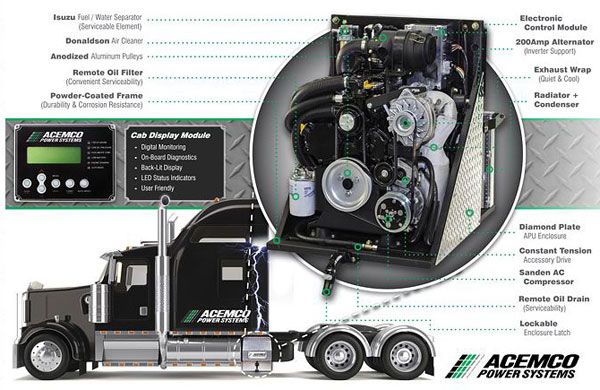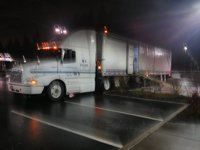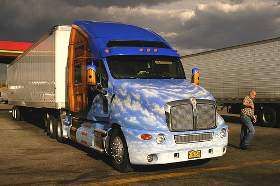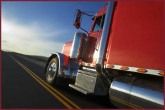An In-depth Look Inside My LW Truck (a Must See!)
Topic 2976 | Page 1
Along both of the sidewalls is a small window. On the bottom is two power outlets that I have my cooler plugged into. I am not using the other power outlet. Along those plugs is the vent for the A/C for my APU. I don't have available space where I can leave my bag of laundry. So I have it inside a large bag and have it tucked away at the side of my bed. I don't have much room, so sometimes I have to put things where I don't want them to be.

This picture is on my passenger side cabinets above my bed. These cabinets are pretty big. In this cabinet is used for food storage. Things that can rot quickly and must be eaten go in here. I have fruits and vegetables in here as well as bread and seeds.

This picture is the cabinet above my bed that is on the drivers side. This is the cabinet above my head when I lay on the bed. On the left side is my APU control panel.
In the middle is a space cabinet space that is used for all my appliances. I have all my cooking things in here and whatever I use to prepare my food. The cabinet on the right stores food that I can take my time on. Such as chili, soup and candy as well as beef jerky. I also have my dishes in here because if I put them in the middle cabinet then they'll bounce around while I'm driving and annoy me.

This is underneath my bed. Yes it opens up for additional storage space. It is broken down into three sections. Two sections are in this picture. The left section is my storage box that opens on the outside of my truck. It contains all my fluids and additives. It has a few other things I rarely touch. I also have my boots tucked away in here and they're in the back next to the light.
The space on the right is the large middle section. This is the biggest section of all. I keep my water in there. On the left of the box is all my Prime paperwork, below that is my hazmat books that I am required to keep in my truck at all times. The long red box is my three reflective triangles. Inside that box is all my tea. Yes, I have a lot of tea so I needed a large box.
 sleeper berth
sleeper berth
This picture is underneath my bunk on the drivers side. You can clearly see the box and water that you see in the other picture of the opposite side. Right beside the water is a metal "case". That is a part of the bunk heater. On the very right is a small area that really only fits water. I fit two 24 packs in there if I stand them up. Very small but convenient space.
Now, I bet you're staring and saying to yourself "are those bricks?"
Yes, those are bricks. I use them for wheel chocks. Why buy 30$ wheel chocks when you can spend 2$ and get bricks. I find them to be a lot better actually. Firstly, they grip the tire just as well as wheel chocks do. Secondly, they cut through the snow and ice and grip the pavement, unlike wheel chocks which just slide right with the snow. The bricks don't break easily. I have 4 of them. Small, cheap and easy to store.
Yes, you can steal that idea from me.

That picture is the area above my dashboard. I have a few small cabinets and pockets there. On my drivers side is a small cabinet I use for things I might need urgently like the Truck Stop Guide Book. On the right is a cutout for a CB. Above that is a netted area I use that for my plastic spoons, forks, and knives.
The middle cabinet is where I keep my batteries at. It also has tea in it so I don't have to stop for tea when I'm driving. That's also where I store my GPS when I'm not driving. The big hole in the celing above that is where I keep my documents such Bill of Lading and receipts.
On the passenger side is a small pocket and that's where I keep my thermometer that Prime requires us to have. In the small cabinet on the right of that is where I keep my spare pens and my detention stamp. The netted area above that is where I keep all my plastic bags.

So as I'm sure you've witnessed. The space is fairly limited in these LW trucks. But the paychecks are good and I manage just fine!
And as a bonus! As if I didn't provide you with enough information. I will also give you measurements.
From door to door it is 6 1/2 feet.
From the windshield to the back wall behind my bed it is 7 feet 5 inches.
My bed is 33 inches wide and 6 1/2 feet long.
From my bed to the cabinets above my head it is 3 1/2 feet.
In the middle of my truck, from the ground to the roof, it is 6 1/2 feet.
The distance between the edge of my drivers seat and my plastic cabinets is 2 1/2 feet.
Well there you go! I hope it helped and gave you some new ideas! Please provide feedback.
HAZMAT:
Hazardous Materials
Explosive, flammable, poisonous or otherwise potentially dangerous cargo. Large amounts of especially hazardous cargo are required to be placarded under HAZMAT regulations
Sleeper Berth:
The portion of the tractor behind the seats which acts as the "living space" for the driver. It generally contains a bed (or bunk beds), cabinets, lights, temperature control knobs, and 12 volt plugs for power.
HOS:
Hours Of Service
HOS refers to the logbook hours of service regulations.APU:
Auxiliary Power Unit
On tractor trailers, and APU is a small diesel engine that powers a heat and air conditioning unit while charging the truck's main batteries at the same time. This allows the driver to remain comfortable in the cab and have access to electric power without running the main truck engine.
Having an APU helps save money in fuel costs and saves wear and tear on the main engine, though they tend to be expensive to install and maintain. Therefore only a very small percentage of the trucks on the road today come equipped with an APU.

Very nice and informative post! While Steve still holds the record for the longest thread on Trucking Truth, I think you now get the prize for the longest post.
Very nice and informative post! While Steve still holds the record for the longest thread on Trucking Truth, I think you now get the prize for the longest post.
Steve has the longest thread?
Oh snap, you're right he does! He has 243 replies whereas I'm at 202. Not good, I don't like this.
Guess I'm going to have to start updating my Adventures thread to get that first place crown.
Nice Post, lots of good info and because I was curious about the LW Trucks at Prime I'm glad you took the time to give Us a detailed look inside...Thanks

Really cool you got it set up pretty good. I found a video on YouTube a guy was sitting in the sleeper with the curtains closed, looked really small if you close the curtains. But another video showed he got the curtains that go around the windows. Anyway looks good, its bigger than the sleepers at Sygma.

Daniel, are the LW trucks an option at Prime, or do you get assigned one whether you want it or not?

Daniel, are the LW trucks an option at Prime, or do you get assigned one whether you want it or not?
I was told by my recruiter at Prime that I will be assigned an LW truck. I asked him if I could get a standard sized truck, he told me that I would have to wait on one to become available or I could go for the lease to get one quicker. I said I would use the LW till one became available. 
I wanted to start out in a standard tuck, but now that Daniel put it into $s difference. Ill stick it out in an LW for a year or so, need to get my financial life straight before I worry about comfort right now.
New Reply:
New! Check out our help videos for a better understanding of our forum features

















Preview:
This topic has the following tags:
Items To Bring On The Road Life On The Road Photos Truck Equipment Questions Truckers Technology









 TT On Facebook
TT On Facebook
Lately, I've seen so many people curious about these LW trucks. So I'll be spending an hour or two creating this thread to inform you about LW trucks.
LW is an abbreviation for Light-Weight. Meaning a truck that is lighter in weight compared to the usual truck that's on the road. Now let me also say, when I say a "fullsize" truck I mean a truck that has cabinets behind the seats and has two beds in the back.
Having a LW truck is a compromise. You're giving up comfort and space for more income. These trucks are very popular at Prime Inc., but they can also be found in small numbers in other carriers. The pay increase for driving a LW truck is .05 CPM. Which doesn't seem like a whole lot but its actually pretty significant. Here's some math:
If I drive 1000 miles as a LW. I will make an extra 50$ pay for driving a LW. That's 50$ PER 1000 miles. So if you drive 2,500 miles in a week you have just earned an extra 125$ dollars in that week. Do that 4 times in a month and that's an extra 500$ that you otherwise wouldn't have earned if you were a fullsize truck.
A LW truck weighs less than so you can haul more freight. In other words, the carrier can charge more because they're transporting more product. A LW truck is also a lot more fuel efficient. The engine is smaller and the speed is governed at 57 MPH for additional fuel savings. Not everyone can live in a truck, and even less of the population can live in a lightweight truck. There are no cabinets and the space is very limited. But if you want to earn great money as a company driver. Then driving a LW truck is the best option.
I've pulled loads up to 49,000 pounds with still some room to spare on my axle weights. It is said that a LW truck can take a 50,000 pound load with 1/2 tank of fuel. Whereas my fullsize Freightliner from Central Refrigerated can only handle about 45,300 pounds and that's if I'm maximum weights on all my weights.
Consider this also, the truck is just a small fraction of the total weight of the entire unit (tractor and trailer). As I've said before, imagine driving a Honda Civic hauling an oversized, giant boat. The weights in the back and can push you around a whole lot easier. Having said that, you go up hills a lot slower because you're pulling more weight and you have a smaller, less powerful engine. You also go down hills a whole lot less in control. The weight is all behind you just forcefully shoving you down.
It is not natural to haul 50,000 pounds of product and then combine that with the weight of the trailer right behind such a small and light truck. I think you see where I'm going with this. I find myself driving "differently" than I used to when I drove a fullsize truck at Central.
Here is a look inside my LW truck.
My seat and my dashboard. Underneath my seat along the door is where I keep my gloves, hammer, and other tools. I have a hammer to bring seals and to thump tires. I have PVC garden gloves because they are waterproof and work great. Even though they look silly, I don't care. I also have 4 bungees there. Why? Well because then I don't have to go underneath my bed and fish out bungees. I have 4 bungees there and I use them to drain my air tanks every morning. Just hook up the metal hook to the line coming out of the air tank and then hook the other end to something. It'll stretch it out and release all the air while you sit inside your warm truck. You'll thank me later when you drain your air tanks in super cold weather.
This is where my passenger seat is supposed to be. It is removed for the extra space. I recommend you remove the passenger seats in the LW trucks, it really opens the place up.
On the left is my Quallcomm mounted on the dashboard. On the right is my cooler where I keep my eggs, carrots, and juices inside. Near the cooler I have two 1 gallon jugs of water used for brushing my teeth when there isn't water available. Yeah, can you imagine that? Sometimes we don't have access to running water!! Next to the cooler is my broom.
Wondering about those plastic cabinets? Well, in a LW truck there is no giant cabinet that you can hang your clothes in. So I bought two plastic cabinets from walmart. In these two cabinets I keep all my clothes in as well as all my shower accessories. I have it bungeed with these bungees so that they won't move. Also, joined together the cabinets create a nice flat surface. That flat surface is my kitchen table. I do all my cooking on top of them. Its my only flat surface that is solid.
Here is my bed on the drivers side. I have a/c - music controls and a reading light. Above me also is my APU control panel. On the bottom is my bunk heater control knob and the vent is right beside it. Along the back wall is a safety net you use when you're sleeping while someone else is driving. I have my laptop inside my laptop backpack and I have the backpack mounted and tucked away within the safety net. This reduces the laptop pounding when you're on rough roads. I also keep my laptop right by the bed so that no one can see it if they take a peak inside my window. sleeper berth
sleeper berth
cabin" title="inside of Prime truck sleeper berth cabin"/>Sleeper Berth:
The portion of the tractor behind the seats which acts as the "living space" for the driver. It generally contains a bed (or bunk beds), cabinets, lights, temperature control knobs, and 12 volt plugs for power.
CPM:
Cents Per Mile
Drivers are often paid by the mile and it's given in cents per mile, or cpm.
HOS:
Hours Of Service
HOS refers to the logbook hours of service regulations.APU:
Auxiliary Power Unit
On tractor trailers, and APU is a small diesel engine that powers a heat and air conditioning unit while charging the truck's main batteries at the same time. This allows the driver to remain comfortable in the cab and have access to electric power without running the main truck engine.
Having an APU helps save money in fuel costs and saves wear and tear on the main engine, though they tend to be expensive to install and maintain. Therefore only a very small percentage of the trucks on the road today come equipped with an APU.